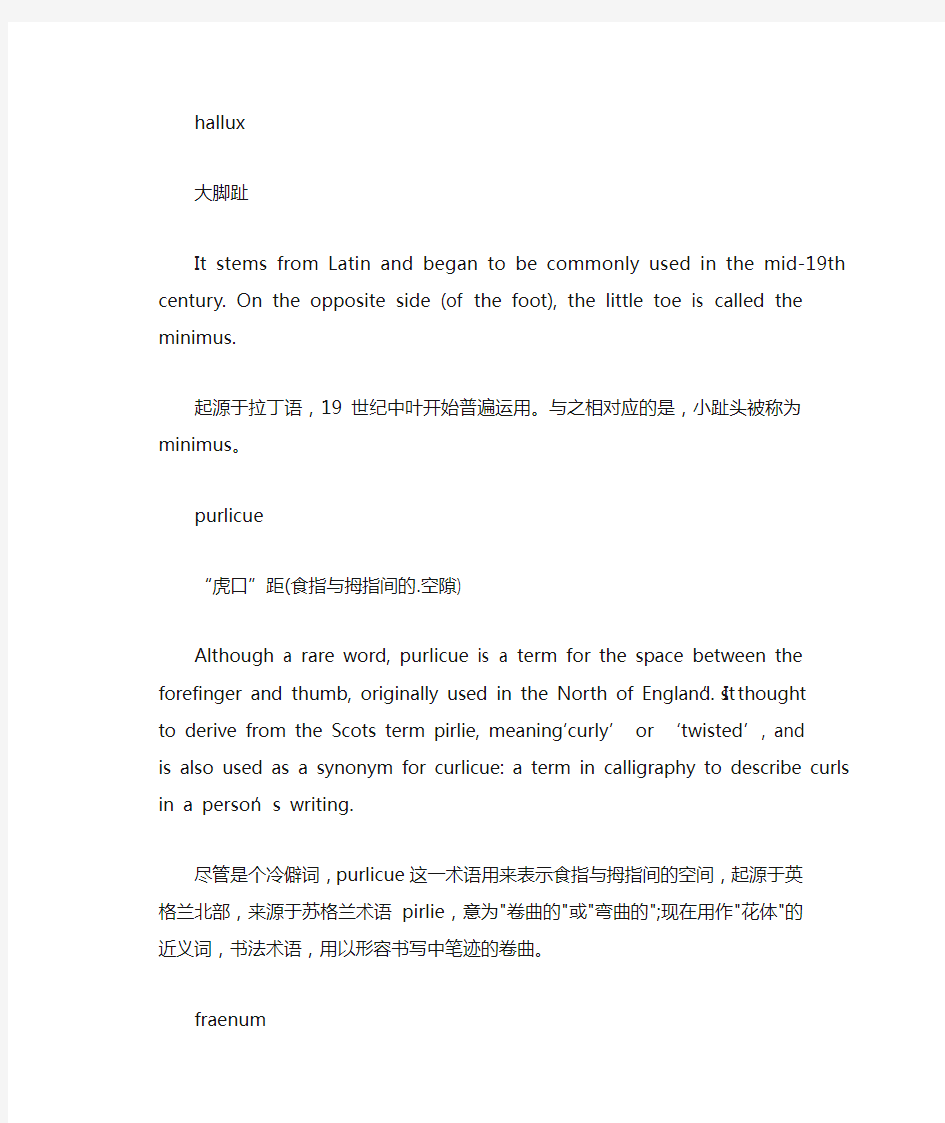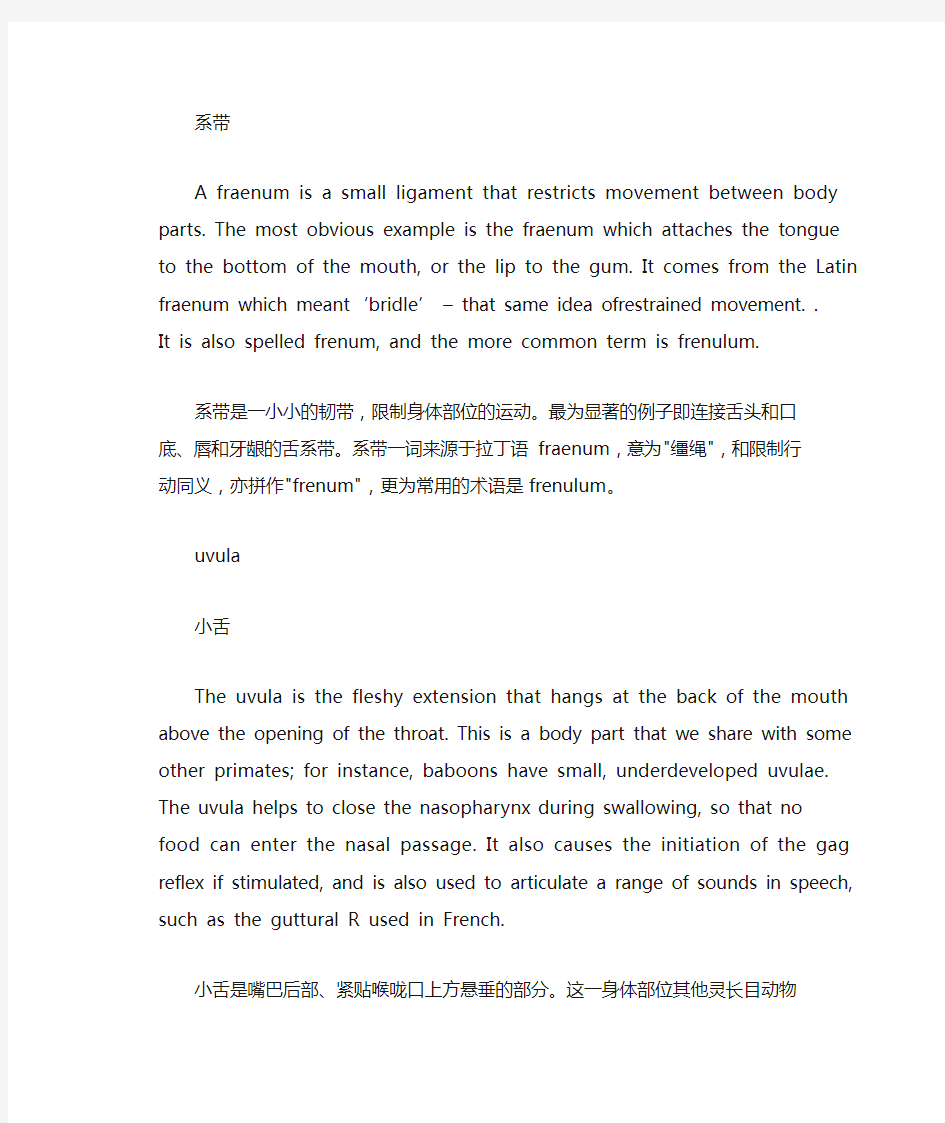

hallux
大脚趾
It stems from Latin and began to be commonly used in the mid-19th century. On the opposite side (of the foot), the little toe is called the minimus.
起源于拉丁语,19世纪中叶开始普遍运用。与之相对应的是,小趾头被称为minimus。
purlicue
“虎口”距(食指与拇指间的.空隙)
Although a rare word, purlicue is a term for the space between the forefinger and thumb, originally used in the North of England. It’s thought to derive from the Scots term pirlie, meaning ‘curly’or ‘twisted’, and is also used as a synonym for curlicue: a term in calligraphy to describe curls in a person’s writing.
尽管是个冷僻词,purlicue这一术语用来表示食指与拇指间的空间,起源于英格兰北部,来源于苏格兰术语pirlie,意为"卷曲的"或"弯曲的";现在用作"花体"的近义词,书法术语,用以形容书写中笔迹的卷曲。
fraenum
系带
A fraenum is a small ligament that restricts movement between body parts. The most obvious example is the fraenum which attaches the tongue to the bottom of the mouth, or the lip to the gum. It comes from the Latin fraenum which meant ‘bridle’–that same idea ofrestrained movement. . It is also spelled frenum, and the more common term is frenulum.
系带是一小小的韧带,限制身体部位的运动。最为显著的例子即连接舌头和口底、唇和牙龈的舌系带。系带一词来源于拉丁语fraenum,意为"缰绳",和限制行动同义,亦拼作"frenum",更为常用的术语是frenulum。
uvula
小舌
The uvula is the fleshy extension that hangs at the back of the mouth above the opening of the throat. This is a body part that we share with some other primates; for instance, baboons have small, underdeveloped uvulae. The uvula helps to close the nasopharynx during swallowing, so that no food can enter the nasal passage. It also causes the initiation of the gag reflex if stimulated, and is also used to articulate a range of sounds in speech, such as the guttural R used in French.
小舌是嘴巴后部、紧贴喉咙口上方悬垂的部分。这一身体部位其他灵长目动物也有,比如狒狒有小型但发育并不完全的小舌。小舌有助吞咽时闭合鼻咽,避免食物进入鼻道。若受到刺激,小舌会引发咽反射;小舌还能用以清晰地发出一系列音,如法语里喉音r。
philtrum
人中
This term refers to the vertical groove between the bottom of the nose and the upper lip. Interestingly, it comes from the Latin word philtrum which initially meant ‘love-potion’ or ‘love-charm’ and only started being used in English for the body part in the 17th century.
这一术语指的是鼻子底部和上唇间竖直的凹陷部分。有趣的是,这个词来源于拉丁语philtrum ,最初意为“爱情”或“爱情魔咒”,直到17世纪才开始用于英语表示身体部位。
gowpen
碗状(两手靠拢形成)
This is the hollow that is formed when the two hands are placed together to create a bowl shape. It originates from the Old Norse gaupn.
这个词指的是双手靠拢形成的碗状时双手凹陷的部分,来源于古挪威语gaupn.
gynaecomastia
男性乳房
The technical medical term for what some might refer to in everyday conversation as ‘man boobs’ or ‘moobs’– or, rather, the condition that causes the swelling of a man’s breast tissue, usually caused by hormone therapy or imbalance.
这一专业术语即有些人日常对话中所说的“男性乳房”,更确切地说,是引发男性胸部组织肿胀、隆起的条件,通常由激素疗法或内分泌失调所致。
canthus
眼角
Stemming from Latin, and from the Greek word kanthos, this word refers to the point in the inner or outer corner of the eye where the upper and lower eyelids meet. It was first used in the mid-17th century.
源自拉丁语和希腊语 kanthos一词,用以指内外眼角上下眼睑交汇处。最初用于17世纪中叶。
gnathion
颔下点
This is the lowest point of the jawbone, so the most outward pointing part of the chin. It comes from the Greek word for ‘jaw’ with the –ion suffix added to it, and only came into usage in the late 19th century.
下颌骨的最低点,是下巴最为向外突出的点,来源于希腊语jaw一词,加上-ion后缀,直到19世纪末期人们才开始使用这个词。
glabella
印堂
The glabella is the smooth part of the forehead, between and directly above the eyebrows. The term comes from the Latin glaber, meaning ‘without hair, smooth, bald’. It is used medically to test for dehydration, as the skin becomes wrinkled and shrivelled when dehydrated.
额头眉间稍高处平整光滑的部分。这个术语来源于拉丁语glaber, 意为“没有毛发、平整、光秃”。医学上用以测试是否脱水,因为脱水时皮肤会收缩、形成褶皱。
head头 , hair头发 , skull颅骨, 头盖骨 ,bald head 秃头, brain 脑 . neck脖子, face 脸, cheek 脸颊, ear 耳,eye 眼. lid 眼睑 , nose 鼻子 , mouth 嘴, lip 嘴唇. throat 咽喉, tonsil 扁桃腺 , tooth 牙齿 ,denture 假齿. gum 牙龈. tongue 舌头, chin 下巴, forehead 额头. temple 太阳穴, mustache 小胡子, beard 山羊胡. whisker 络腮胡 , sidebums 鬓角, wrinkle 皱纹. mole 痣, freckle 雀斑 ,dimple 酒涡,pimple 粉刺. nipple 乳头,chest 胸部,navel 肚脐,abdomen 腹部. shoulder 肩,back 背,waist腰,hip 臀部,buttock 屁股. collarbone 锁骨,rib 肋骨,backbone 脊骨, 脊柱. breastbone 胸骨,joint 关节,pelvis 骨盆,sinew 腱,muscle 肌肉 bone 骨,skeleton 骨骼,blood vessel 血管,vein 静脉. artery 动脉,capillary 毛细血管,nerve 神经,spinal marrow 脊髓. kidney 肾脏,windpipe 气管,lung 肺,heart 心脏,diaphragm 隔膜. organ 器官,gullet 食道,stomach 胃,liver 肝脏,gall 胆囊. bladder 膀胱,pancreas 胰腺,spleen 脾,duodenum 十二指肠. small intestine 小肠,large intestine 大肠,appendix 盲肠. rectum 直肠,anus 肛门,urine 尿道,ovary 卵巢,womb 子宫. vagina 阴道. thumb 大拇指,forefinger 食指,middle finger 中指. third finger 无名指,little finger 小指,palm 手掌,nail 指甲. fist 拳头,knuckle 指关节,back 手背,wrist 手腕,elbow 肘. armpit 腋下. thigh 大腿,kneecap 膝盖骨,thigh 大腿,knee 膝盖. shank 小腿,calf 小腿肚,foot 脚,instep 脚背,toe 脚趾. ankle 踝,heel 脚后跟,sole 脚底,arch 脚掌心.
小学英语“人的器官”教学设计 一.教学目标 1.[知识目标]听、说、认读head、face 、ear、 nose 、mouth、 eye;听懂、理解句子Look at me . This is my nose /eye…… ;快速反应Touch your head /eye/…… 2.[能力目标]培养学生听、做、说、读的能力,增进身体各部位的协调能力和语言表达能力。 3.[情感目标]让学生通过运用语言来完成学习任务,感受成功,从而引发和培养学生学习英语的内在动机,最终使他们形成学习英语的积极态度。 二.教学重点 本课的教学重点是让学生能听、说、认读六个人体部位的单词。教学难点是让学生能将这六个词汇运用到简单的英语句子中。突出重点和难点的关键是结合低年级学生喜欢跳跳、唱唱,喜欢游戏的特点,通过快速反应Let’s do,将单调的知识融入生动的活动之中,让学生在听、说、动的过程中,掌握知识并加以灵活运用。 .三.教学过程 一.导入设计 (1)Free talk 上课一开始,教师让学生进行日常口语交流,教师先示范自我介绍:Morning!Nice to meet you. Hello! I’m M r …..然后让学生进行自我介绍。 (2)Listen and act 教师说:Open your pencil-case. Close your books……让学生做出动作。 [设计思路]提高对知识的再现率,为学习新知识埋下伏笔。同时活跃课堂气氛,调动学生的学习兴趣,使课堂教学以轻松活泼的形式开始。 二.新课呈现 教师依次出示head、face、ear、nose、 mouth、eye等头饰,结合身体语言,逐个呈现这些新单词,然后教师采用升降调逐个带读这几个单词,再指名让学生读一读。
英语公开课教案 Welcome unit My body 1课时(45分钟) Wendy zhang Teaching contents: 1.利用图片学习新的身体部位词汇。 2.能说出自己的身体部位。 3.能运用身体部位词汇掌握和其相关的词汇。 Teaching difficulties: 1.学生能说出身体部位。 2.能掌握和身体部位相关词汇。 Teaching props: 1.多媒体课件 2.黑板 Teaching procedure: STEP一: Review the old words nose mouth eye head face eye 1. play a game (touch your body) (4分钟) 2. 用课件呈现图片,让学生拼写出图片所表示的词汇,并在图片上以句子的形式展示出此单词的复数形式。(5分钟) STEP二: (一)Lead in (6分钟) 让学生看着课件上的图片并回答以下问题 1.What’s this? /What’re they? -----A shoulder. / Shoulders. 图片上呈现此单词的单复数形式 2.What’s this? /What’re they? -----An arm. / Arms. 图片上呈现此单词的单复数形式 3.What’s this? /What’re they? -----A knee. / Knees 图片上呈现此单词的单复数形式 4.What’s this? /What’re they? ----A leg. / Legs. 图片上呈现此单词的单复数形式 5.What’s this? /What’re they? -----A hand./ Hands. 图片上呈现此单词的单复数形式 6.What’s this? /What’re they? -----A neck./ Necks. 图片上呈现此单词的单复数形式 7.What’s this? /What’re they? -----A tooth./ Teeth. 图片上呈现此单词的单复数形式 8.What’s this? /What’re they?
英语公开课教案 My body 1课时(45分) Teaching contents: 1.利用图片学习新的身体部位词汇。 2.能说出自己的身体部位。 3.能运用身体部位词汇掌握和其相关的词汇。 Teaching focus: 1. 在语境中让学生了解身体部位名称及功能。 2. 会用人体器官的各种动作表达自己的情感和意愿。 Teaching difficulties: 1.学生能说出身体部位。 2.能掌握和身体部位相关词汇。 Teaching props: 1.多媒体课件 2.黑板 Teaching procedure: STEP一: Review the old words nose mouth eye head face eye 1. play a game (touch your body) (4分钟) 2. 用课件呈现图片,让学生拼写出图片所表示的词汇,并在图片上以句子的形式展示出此单词的复数形式。(5分钟) STEP二: (一)Lead in (6分钟) 让学生看着课件上的图片并回答以下问题 1.What’s this? /What’re they? -----A shoulder. / Shoulders. 图片上呈现此单词的单复数形式 2.What’s this? /What’re they? -----An arm. / Arms. 图片上呈现此单词的单复数形式 3.What’s this? /What’re they? -----A knee. / Knees 图片上呈现此单词的单复数形式 4.What’s this? /What’re they? ----A leg. / Legs. 图片上呈现此单词的单复数形式 5.What’s this? /What’re they? -----A hand./ Hands. 图片上呈现此单词的单复数形式 6.What’s this? /What’re they? -----A neck./ Necks. 图片上呈现此单词的单复数形式 7.What’s this? /What’re they? -----A tooth./ Teeth. 图片上呈现此单词的单复数形式
[标签:标题] 篇一:小学常用单词顺口溜 动物名词歌 Bird , bird是小鸟,小鸟bird天上飞;bee bee是蜜蜂,蜜蜂bee采蜂蜜; butterfly 是蝴蝶,蝴蝶butterfly真美丽;Fly fly是苍蝇,苍蝇fly真讨厌; spider spider是蜘蛛,蜘蛛spider把网织;cow cow是奶牛,奶牛cow黑白花; horse horse是小马,小马horse跑得快;sheep sheep是绵羊,绵羊sheep真可爱; goat goat是山羊,山羊goat尖尖角;cock cock是公鸡,公鸡cock报晨时; hen hen是母鸡,母鸡hen下鸡蛋;duck duck是鸭子,鸭子duck嘎嘎叫; dog ,dog是小狗,小狗dog汪汪叫;cat ,cat是小猫,小猫cat喵喵叫; rabbit rabbit是兔子,兔子rabbit 来回跳;mouse mouse是老鼠,老鼠mouse可真坏;ant ant 是蚂蚁,蚂蚁ant知晴雨;frog frog是青蛙,青蛙frog雨天现; snake snake是毒蛇,毒蛇snake把人伤;monkey ,monkey是小猴,小猴monkey逗人笑; elephant ,elephant是小象,小象elephant鼻子长;giraffe giraffe 长颈鹿,长颈鹿giraffe个子高; zebra ,zebra是斑马,斑马zebra黑白纹;panda ,panda是熊猫,熊猫panda胖乎乎; Bear Bear 是狗熊,狗熊bear可真壮;tiger ,tiger是老虎,老虎tiger真威武; fox fox是狐狸,狐狸fox 最滑头;Crocodile crocodile是鳄鱼,鳄鱼crocodile真丑陋;我们一起来牢记,保护动物爱自然。 小猫cat喵喵喵,mouse听了拼命逃;小狗dog汪汪汪,把门守得牢又牢; 小鸟bird叽叽叽,飞来飞去真欢喜;鸭子duck嘎嘎嘎,河里鱼虾随便抓; 青蛙frog呱呱呱,池边小虫害怕它;公鸡rooster喔喔啼,每天它都早早起; 狮子lion吼声大,非洲草原它老大。 Dog dog汪汪汪Cat cat喵喵喵Duck duck嘎嘎嘎Monkey monkey尾巴长 Panda panda是国宝Rabit rabit跳一跳Pig pig睡懒觉Bird bird展翅飞Bear bear高又壮Elephant elephant鼻子长Mouse mouse偷油吃Squirrel squirrel会爬树 更多常见小动物英语单词 ox牛bull公牛cow母牛pig,swine猪deer鹿reindeer驯鹿camel骆驼kitten,kitty,pussy小猫lion狮leopard豹yak牦牛wolf狼rat鼠mouse家鼠gorilla大猩猩bat蝙蝠whale鲸dolphin 河豚seal海豹eagle鹰turkey火鸡peacock孔雀goose鹅swan天鹅dove鸽woodpecker啄木鸟parrot鹦鹉crow乌鸦blackbird乌鸫magpie喜鹊swallow燕子robin知更鸟lark百鸟,云雀penguin企鹅owl枭,猫头鹰snake蛇cobra眼镜蛇walllizard壁虎turtle龟seaturtle海龟rog 青蛙bullfrog牛蛙puppy小狗 水果的英语: Apple ,apple是苹果,苹果apple大又红;orange ,orange是橘子,橘子orange圆又扁; banana ,banana是香蕉,香蕉banana黄澄澄;grape ,grape是葡萄,葡萄grape一串串; peach ,peach是桃子,桃子peach像心红; pineapple ,pineapple是菠萝,菠萝pineapple多小孔;mango ,mango是芒果,芒果mango人人爱;watermelon ,watermelon是西瓜,西瓜watermelon 似蜜甜; pear ,pear是鸭梨,鸭梨pear脆又甜。 小朋友们都喜欢,水果富含维生素,大家吃了身体棒。 文具英语单词顺口溜一:
小学英语备课教案 第一节课 主题:身体部位(头部)英语表达法 内容:head, eye, nose, ear, mouth. 上课时间:45mins 备课人:梁好 Presentation and Time Allotment: 1、Greeting(2mins) Good morning! Boys and girls!(学生会用上一节课所学的回答我)2.Introduce. 在黑板上画一个人的头部,取名Mike.教师指着Mike 的头说This is Mike's Head, 然后指着自己的头向同学介绍:This is my head, this is my eye.问同学Where is your head?汉语重复,头是哪里?待学生都正确了后,教读单词head,重复教读几遍(5minutes)。 3.对于剩下部位也照此教授(20 minutes) 4.交完之后,做一个小游戏,老师说,如“touch your head”,看谁又快又准的反应(3minutes). 5.学一首于身体部位相关的儿歌head, shoulder, hands and feet(10 minutes)边唱边做动作 6.总结本节课所学及教学生在四线三格的本子上书写这几个新单词,布置作业(5minutes)
第二节课 主题:身体部位英语表达法 内容:hair, face, shoulder, hand,foot 上课时间:45mins 备课人:梁好 Presentation and Time Allotment: 1.打招呼,热身(10 minutes) 复习上节课所学歌曲;复习上节课所学的几个关于面部表达的英文单词; 2.教授剩下几个小学阶段要求掌握的关于身体部位的英文单词:hair, face, shoulder, hand,foot,大致步骤和第一节课差不多(20 minutes) 3.小游戏。让学生到黑板上画跟这些身体部位的词,下面的同学来猜是什么(8 minutes) 4.教学生在四线三格的本子上书写这几个新单词(7minutes) 5.总结及布置作业